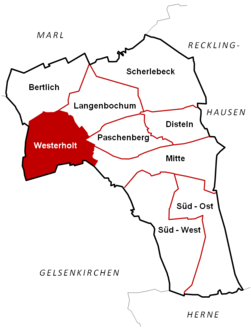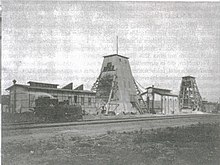Westerholt (Herten)
|
Westerholt
City of Herten
Coordinates: 51 ° 36 ′ 2 ″ N , 7 ° 5 ′ 30 ″ E
|
|
|---|---|
| Height : | 70 m |
| Area : | 4.02 km² |
| Residents : | 11,438 (Dec. 31, 2005) |
| Population density : | 2,845 inhabitants / km² |
| Postal code : | 45701 |
| Area code : | 0209 |
|
Location of Westerholt within the city of Herten
|
|
|
Westerholt from a height of approx. 600 m
|
|
Westerholt is a district of the city of Herten in the North Rhine-Westphalian district of Recklinghausen in the northern Ruhr area .
geography
Townscape
Today's Westerholt is characterized in its historical center by the Westerholt Castle with the adjoining former " Freedom Westerholt", consisting of around 60 well-preserved half-timbered houses ("Old Village"). In addition, the townscape is largely determined by the parts that were created outside of Liberty when the mining industry moved in in 1907: the Westerholt colliery with its colliery structures, railway systems and administration buildings as well as the surrounding mining settlements (" colony ") as well as the commercial and residential buildings that are local Merchants and craftsmen built with the arrival of large numbers of miners ("Heide"). In the 1960s and 1970s, new housing estates with private homes and apartment buildings emerged on the formerly agricultural land ("Ebbelich", "Sickelmannskamp", "Hof Ellinghaus") around the core area of Westerholt.
history
First mentions
Westerholt (HOLT im WESTEN = wood (forest) in the west of Recklinghausen) was first mentioned in 799 as the "Holta" farm of the Werden Abbey. In 1047 the family of the Counts of Westerholt , who were seated at the Westerholt moated castle , was first mentioned in a document.
Origin of Freedom
Around the castle with ramparts and double moats, secured with two gates, the castle servants, craftsmen and other settlers who sought protection of the castle settled. This castle settlement grew around the parish church of St. Martini, which is mentioned in 1310. The settlement was fortified with ramparts and moats and had 3 access gates.
It is not exactly dated when Westholt was raised to " freedom ", but "Freiheit Westerholt" was first mentioned as such in 1421. In 1454 around 300 people lived there in around 45 houses. The former "Freiheit Westerholt" was characterized by the personal freedom of the individual residents, the inheritance of property, regular market days, the fortification of the place and its own administration.
From 1500
From the 16th century onwards, war, occupations and the plague hampered economic development. In the years 1582, 1591 and 1618 fires destroyed the houses in freedom. But the Westerholter showed a great will to assert themselves. They rebuilt their half-timbered houses, mostly using the old wooden beams and stones. They restored the Liberty Gate and built a poor house and school.
The Bürgererschützengilde Westerholt 1583 has existed since 1583.
Many families in Westerholt lived from the manufacture and sale of woolen and cloth items. Widespread professions were therefore cloth makers , weavers and flax farmers . Many men were out and about as " Kiepenkerle " in the Münsterland and Holland to sell the Westerholter cloths there.
Anna Spiekermann was the last victim of the witch persecution in Vest Recklinghausen . After 15 months in prison, she was executed by beheading on July 31, 1706 in Westerholt. The court files are preserved in the Recklinghausen city archive .
After the great fire of August 27, 1808 , large stone houses were built on “Brandstrasse” instead of the half-timbered houses that had burned down in the old village.
After the French era , Westerholt first belonged to the Buer mayor and from 1844 to the Buer office in the Recklinghausen district of the Prussian province of Westphalia . Westerholt Castle was built in its current form in 1830. The previous castle, which stood in the same place, had burned down.
In 1870 Westerholt had about 750 inhabitants with about 105 houses and 32 barns. As a rule, each house of the "Alte Freiheit" had a large garden plot on the "Heide", which the respective house owners had received as private property when the common pastures of the place were divided.
Entry of mining
Only with the arrival of mining - in particular the sinking of the independent Westerholt 1/2 shaft system around 1907 - did Westerholt flourish again. The decommissioned on 19 December 2008 and for local government reform in Gelsenkirchen-Hassel lying colliery Westerholt was built. Outside the gates of the “Alte Freiheit”, the first collieries (colony) were built for the miners who came from all parts of Germany. The population in Westerholt increased steadily.
The merchants and craftsmen from the village built residential and commercial buildings on the “heath” - outside the boundaries of freedom - on the areas of their gardens there. Most of them sold their half-timbered houses in the village, which now did not have their own gardens on the heath.
The new residents of the village were mostly workers, craftsmen, innkeepers and small tradespeople from the surrounding area, who found a livelihood and a livelihood through the new mines and settlements.
The municipality of Westerholt formed its own office in the Recklinghausen district from 1911 to 1934 . On January 30, 1939, the now free municipality was given the name "City" .
Incorporation
With the Ruhr Area Law , which came into force on January 1, 1975, Westerholt lost its independence and has been part of the city of Herten since then.
Population development
|
|
|
Information up to 1920: see Heinz Wener, Westerholter Lesebuch, p. 70; 1961 and 1970: census results on June 6 and May 27, respectively; 1974: Determination of the number of inhabitants on June 30th on the occasion of the upcoming municipal reform
Preservation of the old village
It is thanks to the citizens of the old village at the time that freedom did not fall victim to a renovation in the 1960s; After all, the local town planners planned to demolish the old village and to have the modern concrete-purpose buildings built in the Ruhr area cities in its place. With great personal and financial commitment, the owners opposed such intentions. After the incorporation by the city of Herten, which had just lost its own old town due to such building sins , the old houses in the village were placed under monument protection by the state of North Rhine-Westphalia and the necessary restorations were even temporarily funded by the city of Herten. So the historical structures were preserved. The houses as well as the neighboring castle have now been restored in accordance with historical monuments.
politics
Together with the neighboring district of Bertlich, Westerholt has formed a district since it was incorporated.
sons and daughters of the town
- Heinrich Grymhardt († 1419 in Cologne), official of the Archdiocese of Cologne
- Johann Matthias von Westerholt (1685–1729), electoral Cologne privy councilor and councilor in Hildesheim
- Adolf Galland (1912–1996), Air Force officer and fighter pilot
- Joachim Poß (* 1948), politician
- Christian Timm (* 1979), professional soccer player
literature
- Cornelia Kneppe: Westerholt (Herten) (= Historical Atlas of Westphalian Cities. Volume 4). Ardey, Münster 2014, ISBN 978-3-87023-370-9 .
- Cornelia Kneppe: Herten-Westerholt - a freedom at the gates of Recklinghausen. In: LWL-Archäologie in Westfalen, Altertumskommission für Westfalen (Ed.): Archäologie in Westfalen-Lippe 2013. Beier & Beran, Langenweißbach 2014, ISBN 978-3-95741-019-1 , pp. 177-181, doi: 10.11588 /aiw.0.0.26061 .
- Heinz Wener: Westerholt. Tell old pictures. Sutton, Erfurt 2003, ISBN 3-89702-601-5 .
- Heinz Wener: Westerholter reading book. Interesting news from the past. Michael Lackmann, Westerholt 2001, ISBN 3-921052-84-X .
- Heinz Wener: Westerholt in old views. 2 volumes. European Library, Zaltbommel / Netherlands 1994/1995, ISBN 90-288-1909-6 and ISBN 90-288-5953-5 .
- Ludger Zander: Westerholt. Impressions from history: From imperial freedom to an industrial community. City of Herten, Herten 1992.
Web links
- List of architectural monuments in Herten
- Old village of Westerholt Information from the city of Herten
- Document registers from the archive of the Westerholt family at Westerholt Castle / digital Westphalian document database (DWUD)
- Herten-Westerholt. Working group for historical town centers in NRW
- Information about the place and the history. Hometown club
- Westerholt in the Westphalia Culture Atlas
Individual evidence
- ^ Formation of the Buer office. In: Official Gazette of the Münster government , 1844
- ^ Wolfgang Leesch: Administration in Westphalia 1815-1945 . In: Publications of the Historical Commission for Westphalia . tape 38 . Aschendorff, Münster 1992, ISBN 3-402-06845-1 .
- ↑ Stephanie Reekers: The regional development of the districts and communities of Westphalia 1817-1967 . Aschendorff, Münster Westfalen 1977, ISBN 3-402-05875-8 , p. 294 .
- ↑ a b Federal Statistical Office (ed.): Historical municipality register for the Federal Republic of Germany. Name, border and key number changes in municipalities, counties and administrative districts from May 27, 1970 to December 31, 1982 . W. Kohlhammer, Stuttgart / Mainz 1983, ISBN 3-17-003263-1 , p. 316 .
- ↑ Martin Bünermann, Heinz Köstering: The communities and districts after the municipal territorial reform in North Rhine-Westphalia . Deutscher Gemeindeverlag, Cologne 1975, ISBN 3-555-30092-X , p. 89 .











